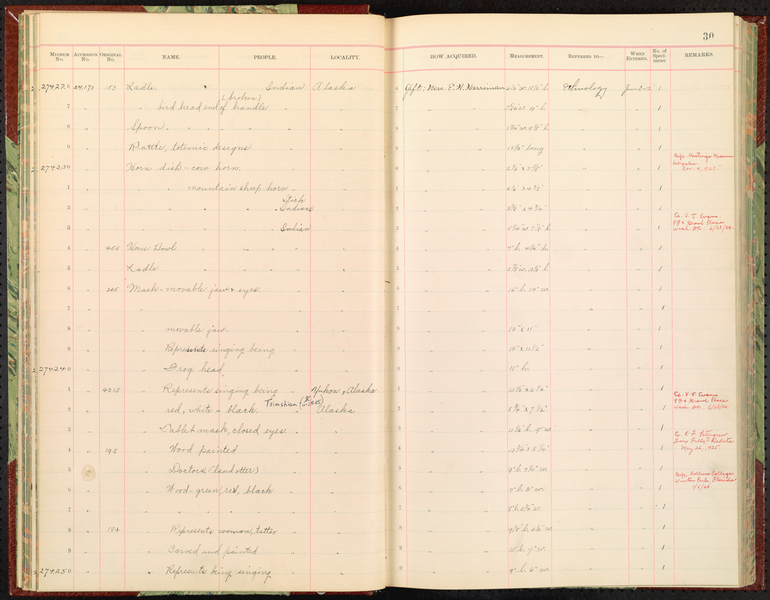Mask Item Number: E274242-0 from the National Museum of Natural History




Notes
From card: "Wood painted red, white and black. Modern carving. According to Norman Tait, Nishga artist, "this is a Tsimshian mask, probably carved on the Skeena River, used for dancing (indicated by black stripe across the face). Carved of alder wood, well done, but quickly done, probably in preparation for a winter dance." (10/21/85). This mask has two catalog numbers: 274242 and 360363. W. Sturtevant requested that the 274242 number be used and the 360363 number be "retired", with a blank card in the file referring to 274242. (Card and ledger books changed by S. Crawford, 10/25/85)." LEDGER AND CATALOG CARD SAY SENT TO VICTOR J. EVANS, WASHINGTON, D.C. AS AN EXCHANGE JUNE 23, 1920.As indicated on the catalogue card, this mask was exchanged with Victor J. Evans in 1920. In 1931, Evans' collection came to the Smithsonian as a bequest, Accession number 113605, and this mask was part of that collection. The mask was given Catalogue # 360363 in the Evans collection. In 1985, at the request of curator Dr. William Sturtevant, the mask was returned to its original catalogue number of 274242.This object is on loan to the Anchorage Museum at Rasmuson Center, from 2010 through 2027.Source of the information below: Smithsonian Arctic Studies Center Alaska Native Collections: Sharing Knowledge website, by Aron Crowell, entry on this artifact http://alaska.si.edu/record.asp?id=675, retrieved 4-24-2012: Mask, Tsimshian, probably Skeena River, British Columbia, Canada. Masks were among the most important objects representing a chief's halaayt (spirit powers). Each portrayed a different guardian spirit in bird, animal, or human form, and each had a unique name and song. Nisga'a artist Norman Tait commented that this example was probably from a Skeena River village and that the black band across the eyes confirmed that it was used for dancing. He thought it was well carved but probably quickly made for a winter ceremony. "If you could call any mask classical Tsimshian, this one has all the features ... these cheekbones, the way the nose is sculpted, the narrow lips, and the way the eyes look down and slightly to the sides. When you dance you're turning from side to side, and that helps you to see where you are going." - David Boxley (Tsimshian), 2009
Item History
- Made in Alaska, USA and British Columbia, Canada ?
- Collected by Gov John G. Brady in Alaska, USA and British Columbia, Canada ? between 1878 and 1909
- Received from Mrs. Edward H. Harriman on June 7, 1912
What
- Name
- Mask
- Identification Number
- E274242-0
- Type of Item
- mask
Who
- Culture
- Tsimshian
- Field Collector
- Gov John G. Brady
- Received from
- Mrs. Edward H. Harriman
Where
- Holding Institution
- National Museum of Natural History
- Made in
- Alaska, USA and British Columbia, Canada ?
- Collected in
- Alaska, USA and British Columbia, Canada ?
When
- Collection Date
- between 1878 and 1909
- Acquisition Date
- on June 7, 1912
Other
- Accession Number
- 054171